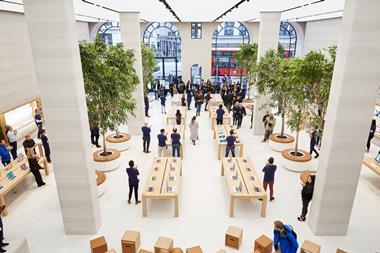In-store tech can help to meet the needs of modern consumers, but investments in innovation must also boost the bottom line.
The Retail Innovation Forum, hosted by Panasonic, recently explored what innovation really means for customers’ in-store experience and how retailers can increase their ROI by using technology.
Blockchain was a hot topic of discussion among the expert speakers, including why it’s important, what makes it disruptive and how it can be used to engender trust.
Delegates learned how blockchain can reduce operational costs, create new revenue streams and ensure data integrity – for example, by reducing the risk of a business falling prey to a cyber attack.
Cathy Mulligan, co-director of the Imperial College Centre for Cryptocurrency Research, also explained how blockchain technology has the ability to help build trust, compliance and efficiency for all stakeholders, as well as eradicate human errors and fraud.
Blockchain case studies discussed at the event looked at its use in the diamond industry and at a well-known US-based supermarket.
Adapting to changing buying habits
Attendees at the Retail Innovation Forum also gained insight into how retailers can harness new technology to support customers’ changing buying habits.
Different generations of consumer have different purchase preferences, which can pose challenges for retailers.
Gen Z, for example, will often browse in store while simultaneously researching information on a smartphone, without retailer assistance.
Meanwhile, the so-called ‘grey pound’ generation value a greater level of staff interaction in store.
“Different generations of consumer have different purchase preferences, which can pose challenges for retailers”
The use of hidden technology – non-invasive technology that works quietly in the background – enables retailers to tailor staff activities and their interaction with consumers based upon intelligent analytics and specific customer knowledge.
One example would be using smart analytics on a store’s CCTV to identify hot spots and dwell times so that staff can be allocated to the areas they are most needed, therefore supporting the customer experience by being in the right place at the right time.
A new standard in retail
Finally, the event focused on one store that is efficient, successful and built on sustainability – the Dublin City University (DCU) Londis store.
The pioneering store has deployed a variety of technologies – many of which are either not yet widely available, or in the early stages of adoption – and sales in the past year have grown 55%.
It was explained how new revenue streams have directly benefited ROI. For instance, the store deployed Panasonic’s The Space Player hybrid lighting technology for flexible, changeable signage. Using dynamic projection, the lighting solution can project multiple images at once, change images based on timeframe and use 3D mapping.
It was realised that this technology could be used for promotional purposes – resulting in paid advertising by certain brands, without them being restricted by the dimensions of digital screens or posters.
“The pioneering store has deployed a variety of technologies, and sales in the past year have grown 55%”
ROI has also been realised at the store through using Pulse Retail Systems software, a new way of controlling margin, creating reports, running campaigns and assessing the performance of key areas.
DCU’s intent – to push the boundaries of retail innovation while delivering on its sustainability goals – is, so far, highly successful. It’s an excellent demonstration of how technology can be used to the benefit of both the business and its customers.
To read more about the topics discussed at the event, click here.

Sean Taylor is head of retail solutions at Panasonic Business, UK




























No comments yet